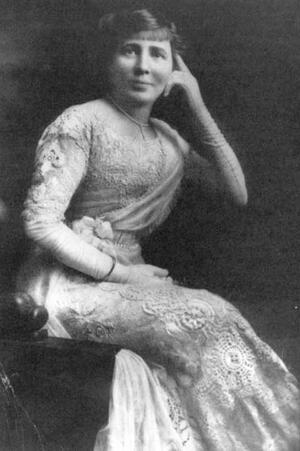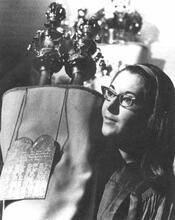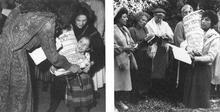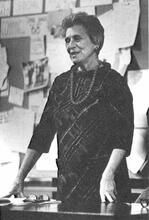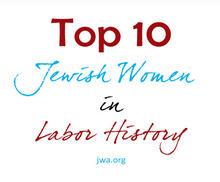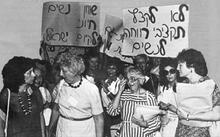National Federation of Temple Sisterhoods
Carrie Obendorfer Simon founded the Reform movement's National Federation of Temple Sisterhoods in 1913. Two years later, it had become the largest Jewish women's religious organization in the United States.
Institution: The Jacob Rader Marcus Center of the American Jewish Archives, Cincinnati, OH, www.americanjewisharchives.org
Uniting local congregational sisterhoods around the United States, in its first years the National Federation of Temple Sisterhoods (NFTS) advanced Jewish religious observance in the home and the synagogue; supported Reform Judaism’s rabbinical seminary, Hebrew Union College; and took up important social service projects, among them creating Jewish reading materials for the blind. During its second half-century, increasingly influenced by wider currents promoting egalitarianism and feminism, NFTS transformed into the Women of Reform Judaism. Today, it remains the leading forum for Reform Jewish women to exercise collective leadership within their branch of modern Judaism.
Founded in 1913 as the National Federation of Temple Sisterhoods and renamed Women of Reform Judaism (WRJ) in 1993 to emphasize the centrality of women within the Reform movement, the WRJ has for more than a century galvanized hundreds of thousands of women to support and advance Reform Judaism, the Jewish people, and Jewish values in their home communities, around the country, and around the world.
Founding and Early History
In January 1913, women representing the sisterhoods and ladies’ temple societies of 52 congregations gathered in Cincinnati to found the National Federation of Temple Sisterhoods (NFTS). Its aims were to forge local women’s synagogue groups—most had been founded in the latter decades of the nineteenth and the first of the twentieth centuries—into greater cooperation to advance their religious, spiritual, and educational activities. The moving force behind NFTS’s creation was Carrie Obendorfer Simon, wife of the rabbi of Washington (DC) Hebrew Congregation. Although she invited Conservative and Orthodox Jewish sisterhoods to join NFTS, within a decade these movements had created their own national denominational associations. Thus these women’s religious organizations became another of the markers concretizing the divisions among the various streams of American Judaism.
At a time when women across the United States were advancing female suffrage and temperance under the banner of large national organizations, Carrie Simon recognized that women’s emancipation was underway. She expected NFTS to exert women’s power and influence within Reform Judaism, in part by influencing religious life in the arenas where they already exercised the greatest sway.
NFTS’s first priority was deepening religious observance in the home. The organization’s National Committee on Religion told members to give Sunday school children menorahs and Chanukah candles and to remind their mothers to light them at home because Chanukah, not Christmas, was a Jewish holiday. While NFTS leaders applauded sisterhoods organizing communal Passover seders, they still wanted the first meal of the holiday reserved for the family in the home.
A second priority was encouraging Sabbath and holiday worship and supporting the synagogue. NFTS published an annual art calendar to hang in the home to show when those holidays fell. To get Jews into the synagogue, NFTS advised members to canvass door-to-door to tell their friends to join them at services. It recommended serving refreshments after Friday evening worship to promote conversation and good cheer and asked members of the sisterhood to sit in the first row of the sanctuary during services to bridge the distance between the congregation and the pulpit.
From the get-go, NFTS wanted to help those who would one day sit on those pulpits. In the old country it had been an honor to house and feed a young man studying for the rabbinate. In America, NFTS translated that tradition into support for Hebrew Union College, Reform Judaism’s rabbinical seminary. By 1919, the women had raised enough money to fund 24 full scholarships for future rabbis. Then NFTS undertook its largest fundraising project to date, the campaign to build a dormitory at the college. When Sisterhood Dormitory opened in 1925, it had space for 100 students. During the Depression, when the college’s finances were exceedingly precarious, its leaders counted on NFTS to pay those students’ tuitions. Subsequently, with the Nazi threat looming ever larger, NFTS raised additional funds to help rescue seven rabbinical students and eleven professors from Europe. Among the professors was Abraham Joshua Heschel, one of the leading Jewish theologians of the twentieth century. Then and today, an ethos of philanthropy lay at the sisterhoods’ core.
NFTS’s promotion of Jewish education reached beyond the rabbinate to children. youth, and its own members. A publication fund produced textbooks for the schoolroom and for adult education. In the late 1920s, NFTS supported Reform’s Young Folks’ Temple Leagues for young adults, and, after World War II, NFTY (the North American Federation of Temple Youth), aimed at high schoolers.
Sisterhoods’ adult education programs encouraged Bible study using the Jewish Publication Society’s 1917 translation. In the 1950s, after the establishment of the State of Israel, some NFTS members began studying the Hebrew language. Over time, in a religious movement that had once jettisoned almost all Hebrew from its liturgy, Hebrew phrases and terms entered sisterhoods’ lexicon.
Promoting religion outside the synagogue became a logical extension of NFTS’s work. In 1927, it circulated a list of 1,330 Jewish college students around the country and urged sisterhoods in those college towns to invite the students to services and to their homes.
Helping the Jewish blind became an early expression of NFTS’s commitment to social justice. Hebrew Union College rabbinical student Michael Aaronsohn was blinded during World War I while rescuing a fellow soldier. Returning to the college after the war and with the help of his sister, he was ordained a rabbi. NFTS supported his life’s work of helping the blind become self-sufficient. Sisterhood women learned Braille to create a library of adult and juvenile Jewish literature, helped found the Jewish Braille Institute of America, and supported the Jewish Braille Review magazine and the development of a Hebrew Braille alphabet.
Politics and Women’s Rights
For many years, NFTS walked a fine line between its commitment to Reform Judaism and broader interests in philanthropy and contemporary politics. NFTS presidents were rightly concerned about not overextending local sisterhoods by venturing into social service and political projects best left to other organizations. They wanted the funds they raised to advance Reform Judaism.
Those funds were considerable. Sisterhood members bought NFTS’s annual art calendars, and synagogues bought its publications. Reform Jewish women scrawled their good wishes for birthdays and milestones and condolences on NFTS Uniongrams, almost three million of which were sold in the four decades after their launch in 1916.
NFTS leaders considered certain issues, notably peace work and separation of church and state in the public schools, as lying at the center of their religious mission. Citing the prophet Isaiah, who envisioned swords beaten into plowshares, in the 1920s NFTS promoted the prevention of war and called for disarmament. When Protestant fundamentalists tried to ramp up the reading and teaching of the Bible in local public schools, many sisterhoods resisted their plans. In the 1940s, they opposed release time bills, which gave schoolchildren time off for religious instruction. Early NFTS resolutions reveal other political issues of consensus—raising funds for the relief of Jews suffering in Palestine during World War I (1915) and supporting the rescue of Ethiopian (Falasha) Jewry (1923).
Despite rhetoric about abstaining from politics, NFTS was concerned from its inception with one major political issue: the changing role of women. Its proceedings are filled with presidents’ speeches and the reports of chairmen, as the heads of its committees were then called, celebrating that, for the woman in Reform Judaism, “the day of her inferiority is a memory of the Dark Ages” (Steinfeld, Proceedings of the UAHC, 1931). But, of course, women’s emancipation in Reform was not then complete, as revealed by the fact that over the years, NFTS continued to wax enthusiastic about women’s “firsts”— the first women elected to synagogue boards, the first time a woman trustee sat on the pulpit during services, the first time a woman read scripture on Yom Kippur. Its leaders told members that, while their rabbis were on vacation, they should lead summer services.
NFTS called for the inauguration of Sisterhood Sabbath, a day for women to play leading roles in the service and even preach to the congregation. In 1930, Barbara Goodman, chairman of NFTS’s committee on religion, called it a day of revelation that showed what women could do if they ever became rabbis. In 1961, just as President John F. Kennedy was convening the U.S. Commission on the Status of Women, NFTS took up the question of women’s rabbinic ordination. A decade would pass before Hebrew Union College would heed its call and ordain a woman.
The Jane Evans Era
During the Depression NFTS lost affiliates as some impoverished sisterhoods resigned and few new ones joined. Yet NFTS was looking ahead when, in 1933, it hired its first full-time executive director, Jane Evans. This “first lady of Reform Judaism,” as she became known, had been raised in a Reform Jewish home and was working in design and retail when she was hired to head NFTS. Her business background proved indispensable. Within her first decade at its helm, she had added some 50 sisterhoods to the membership rosters and doubled the amount of scholarship money raised. Her office handled hundreds of letters every day. She launched new projects to expand NFTS’s imprint: the newsletter Topics and Trends, a radio program of Jewish liturgical music, leadership training institutes, and a speakers’ bureau, which sent a volunteer speaker—often Evans herself—out to every local affiliate. She helped orchestrate NFTS’s fund-raising for a home for Reform Judaism’s national organizations, the House of Living Judaism, and lobbied to see it built in New York, not in Reform’s traditional center of Cincinnati, believing that Reform Judaism required a greater presence in the largest Jewish community in the United States in order to expand. The $500,000 NFTS raised for that project by 1951 are the equivalent of almost $5,000,000 in 2019.
A particularly keen observer of contemporary affairs and a religious pacifist who offered to resign when the United States entered World War II, Evans expected the women to voice their opinions on the issues and challenges of the day. Under Evans, NFTS passed resolutions supporting access to birth control information, civil rights, fair employment practices, child labor legislation, the revision of immigration legislation, the elimination of capital punishment, and the de-escalation of the Vietnam War, as well as support for the Jewish community in Palestine and, after 1948, in the new State of Israel. The organization that had never adopted a resolution in favor of woman suffrage, so as not to alienate members, endorsed the Equal Rights Amendment to the Constitution in 1973, urged sisterhoods to form coalitions with other women’s organizations for the advancement of all women, and supported a woman’s right to abortion in the 1992 “March for Women’s Lives” in the nation’s capital. Evans and her successors, Eleanor Schwartz (1976–1992), Ellen Y. Rosenberg (1992–2003), Shelley Lindauer (2004–2011) and Rabbi Marla Feldman (2012- ), took what was by then known as the Women of Reform Judaism far beyond the domestic sphere of its founders into the larger Jewish world and the arena of women and politics.
Into the 21st Century
Among WRJ’s most important projects in the twenty-first century was the publication of The Torah: A Women’s Commentary (2008), edited by scholars Tamara Cohn Eskanazi and Andrea Weiss. The idea for a feminist Torah commentary dated back to 1991. By the time it appeared in 2008, it was not the only English-language women’s Torah commentary. Nevertheless, when this book, accessible to scholars, clergy, and laity alike, won the Jewish Book Council’s top prize, its Jewish book of the year award, it was lauded for speaking to all of America’s Jews, rather than conveying the message of only one stream.
For its centennial anniversary in 2013, WRJ invited leading scholars to write its history. Sisterhood: A Centennial History of Women of Reform Judaism (2013) proves that NFTS/WRJ stands proudly among the powerhouse organizations of American Jewry. Although the women of Reform Judaism shared with their husbands and brothers their synagogues, Reform’s seminaries and organizations, and Judaism’s religious and humanitarian values, the Women of Reform Judaism created a separate female Reform Jewish culture. In the twenty-first century, sisterhoods run gift shops in their synagogues and sent representatives, in 2019, to the WRJ’s first-ever social justice conference. There Reform Jewish women learned more about ending violence against women, combatting current immigration and refugee polices, and changing gender inequality in Israel. They then carried that knowledge back to their congregations. Though its programs and interests have shifted over time, Women of Reform Judaism changed the expectations of American Jewish women’s proper behavior within the portals of their synagogues and far beyond.
Balin, Carole B., Dana Herman, Jonathan D. Sarna, & Gary P. Zola. Sisterhood: A Centennial History of Women of Reform Judaism. Cincinnati: Hebrew Union College Press, 2013.
Carr, Jessica. “Picturing Palestine: Visual Narrative in the Jewish Art Calendars of National Federation of Temple Sisterhoods.” American Jewish Archives Journal 64, Nos 1 & 2 (2013): 1-34.
Davis, Karen, “The Ascent of Sisterhood: The First Eight Decades.” Reform Judaism (Fall 1992): 37+.
Evans, Jane. Oral history interview with Abraham J. Peck, November 4, 1985. AJA, Cincinnati, Ohio.
Hirt-Manheimer, Aron. “Sisterhood for the ’90s: A Conversation with Ellen Y. Rosenberg.” Reform Judaism (Fall 1992): 40–42.
Nadell, Pamela S., and Rita J. Simon, “Ladies of the Sisterhood: Women in the American Reform Synagogue, 1900–1930.” In Active Voices: Women in Jewish Culture, edited by Maurie Sacks. Champaign: University of Illinois Press, 1995.
National Federation of Temple Sisterhoods. Index of Resolutions, Adopted by the National Federation of Temple Sisterhoods, 1913–1985 (1988), and Proceedings of the National Federation of Temple Sisterhoods (1913–), and Topics and Trends (n.d.).
Rosett, Frieda S. Papers, 1924–1987. Mss Collection number 353, folder 1/3, Speeches, 1924–1943. AJA.
Steinfeld, Mrs. Maurice. “Greetings from National Federation of Temple Sisterhoods.” Proceedings of the Union of American Hebrew Congregations, 57th Annual Report, 1931: 193.
Women of Reform Judaism.

